Physical Address
304 North Cardinal St.
Dorchester Center, MA 02124
Cardiac abnormalities are among the most common birth defects and are the leading cause of death in children from congenital defects. They occur in about 8–11 cases per 1000 livebirths but only 3 per 1000 are major cardiac abnormalities requiring early intervention. Despite well-recognized risk factors ( Table 14-1 ), most cardiac abnormalities occur in low-risk pregnancies. Hence, the best practice is to screen the entire population by assessing the fetal heart during routine fetal ultrasound examination. The fetal heart is fully formed by 8 weeks post-ovulation, therefore, an experienced sonographer with advanced ultrasound equipment is able to assess the fetal heart and exclude the majority of the severe heart malformations as early as 12 weeks of gestation. However, the optimum time for a detailed heart examination is 20–22 weeks’ gestation. Furthermore, the fetal heart should be reassessed during any subsequent scans as some rare conditions such as valvar stenosis, cardiac tumours or tachycardia can present as late as the third trimester.
| Fetal | Maternal | Familial |
|---|---|---|
|
|
|
The methodology of fetal heart examination was first described and successfully implemented more than 30 years ago. For several reasons, fetal echocardiography cannot be directly compared to a postnatal scan. Firstly, the fetal heart lies more horizontally due to the large fetal liver. Secondly, both ventricles are equal in size, with the right ventricle lying directly anterior in the fetus whereas postnatally it is inferior. As the foramen ovale and arterial duct are widely patent in the fetus, they both are readily seen prenatally. Finally, the lungs are not aerated but fluid-filled during fetal life, therefore do not obstruct cardiac imaging as they do postnatally.
The first step towards successful examination of the fetal heart is to obtain a perfect transverse section, as all the details of the heart anatomy can be seen in a transverse sweep of the ultrasound beam from abdomen to neck. Subsequently the heart can be readily analyzed in terms of three basic segments: the atria, the ventricular mass and the great arteries. The atria, ventricular chambers and the great arteries are paired structures with distinguishable left and right characteristics.
This is the most important view, which is easy to obtain and shows many features of both normality and abnormality. Therefore, the four-chamber view should be imaged perfectly and analyzed systematically.
Before beginning to examine the four-chamber view:
The position of the fetus within the uterus must be established.
The stomach and heart must be confirmed as both lying on the left of the fetus.
The position of the aorta in front of the spine in the abdomen, with the inferior vena cava anterior and to the right, establishes normal situs ( Figure 14-1 ).
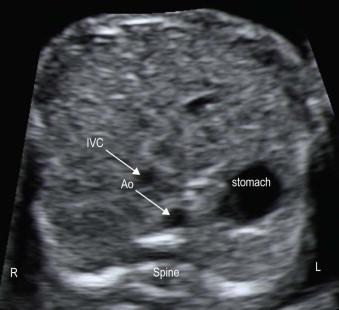
The four-chamber view is obtained in a horizontal section of the fetal thorax just above the diaphragm. One complete rib ( Figure 14-2 ) should be seen to confirm that the section is accurately transverse and so correct. The next step is to orientate and identify the cardiac chambers in the normally connected and positioned heart within the thorax.
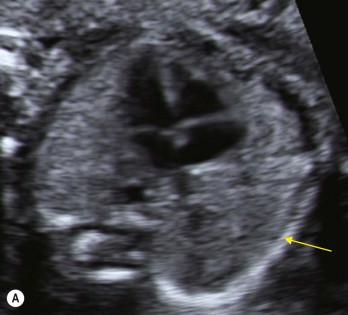
Firstly the spine should be located, then the anterior chest wall (sternum), which is opposite the spine.
The right ventricle lies beneath the anterior chest wall.
The descending aorta is seen as a circular structure lying anterior to the spine.
The left atrium lies anterior to the aorta.
The right atrium is the only chamber located in the right thorax.
The left ventricle lies posterior to the right ventricle ( Figure 14-3 ).
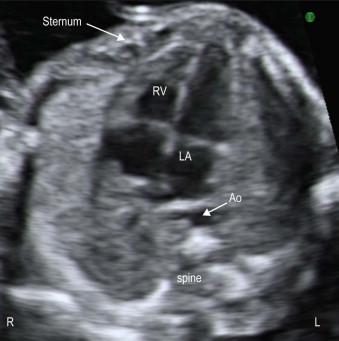
The appearance of the four-chamber view will vary according to the fetal position ( Figure 14-4 A–C ), but whatever the position, four features of normality should be evaluated: size, position, structure and function.
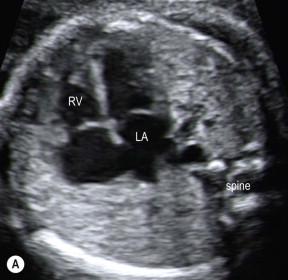
The heart occupies one-third of the thorax or one-half of the thoracic circumference. The size of the fetal heart can be assessed by eye. However, the cardiothoracic ratio can be easily measured in the four-chamber view should there be any doubt. The approximate normal range is 0.55 ± 0.05 ( Figure 14-5 ).
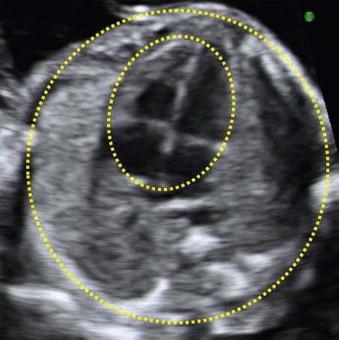
The heart lies mainly in the left chest with the apex pointing to the left. The angle between the ventricular septum and the midline of the thorax is approximately 45 degrees ( Figure 14-6 ).
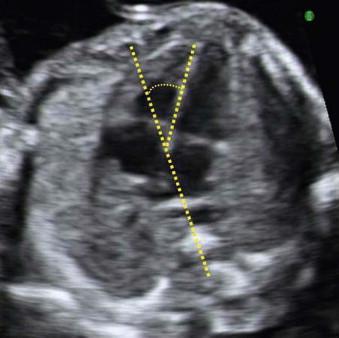
There are two equally sized atria and ventricles, with equal wall thickness. The right ventricle appears more trabeculated than the left and its apex contains the moderator band ( Figure 14-7 ).
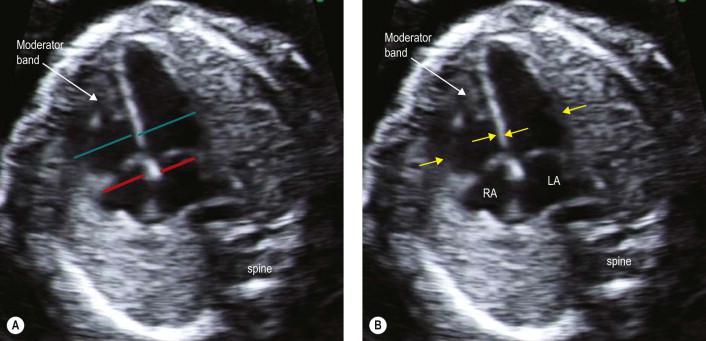
The atrioventricular valves meet the ventricular and atrial septum forming the centre of the heart or crux. The right sided tricuspid valve is a little closer to the apex than the left sided mitral valve, creating characteristic off-setting at the crux ( Figure 14-8 ).
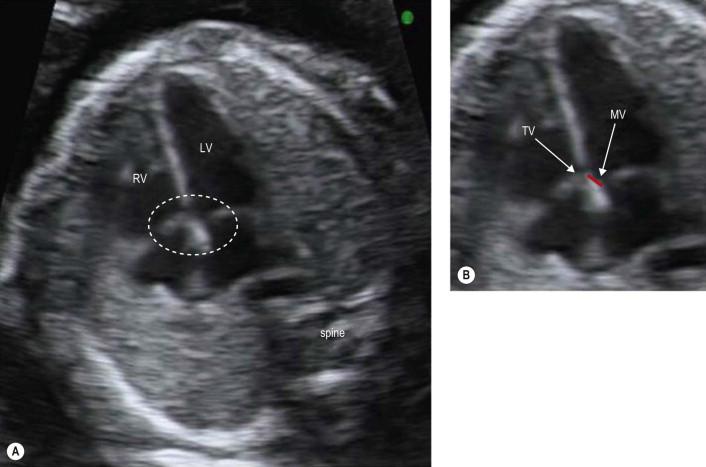
The atrioventricular valves are equal in size. They open simultaneously in ventricular diastole and close in systole.
The ventricular septum should appear intact ( Figure 14-4 ).
There is an interatrial communication (the foramen ovale ) occupying about one-third of the atrial septum ( Figure 14-9 ). The foramen ovale is guarded by a flap valve, which oscillates in the left atrium as a result of blood flow from the right to left atrium in the normal fetal heart.
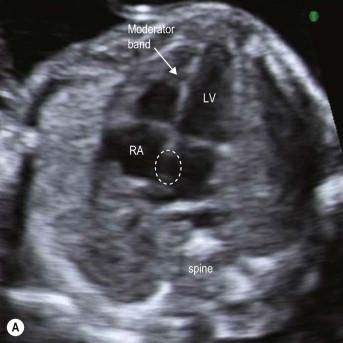
Usually two pulmonary veins are seen at the back of the left atrium. However, they should be confirmed by colour Doppler ( Figure 14-9 and Figure 14-10 ).
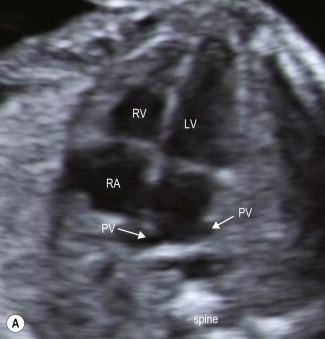
In the normal four-chamber view, there is only one vessel, the descending aorta, seen in the posterior mediastinum lying in front and slightly to the left of the spine ( Figure 14-3 ).
The appearance of a black rim around the ventricles represents fluid in the pericardial sac and is normal ( Figure 14-11 ).
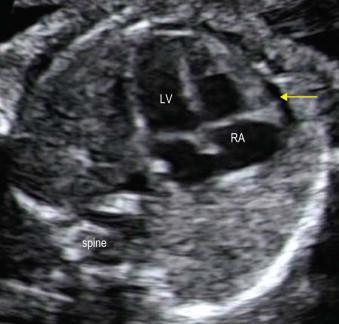
In the last 10 weeks of gestation, the normal fetal heart becomes asymmetric to some extent as the right ventricle ( Figure 14-12 ) and pulmonary artery become slightly larger than the left-sided structures.
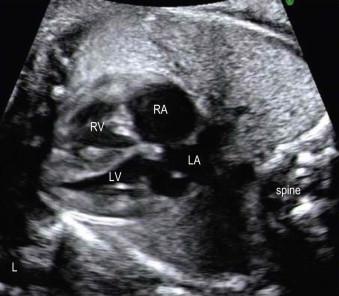
Two equally opening atrioventricular valves and equally contracting ventricles should be identified. It is necessary to use the colour Doppler in order to demonstrate equally filling ventricles and competent atrioventricular valves ( Figure 14-13 ).
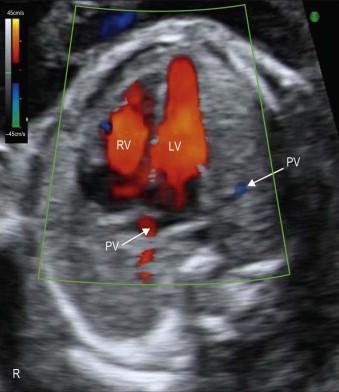
The great arteries and their ventriculo-arterial connections are best seen in a series of transverse planes, imaged in a continuous sweep moving cranially from the four-chamber plane. The aorta is the first vessel seen sweeping towards the right as it arises just above the level of the four-chamber plane ( Figure 14-14 ). In order to image the left ventricular outflow tract perfectly, it might be necessary to rotate the transducer slightly in order to ‘open out’ the aorta. It is very important to image the left ventricular outflow tract sufficiently clearly to ensure that the anterior wall of the aorta is continuous with the ventricular septum ( Figure 14-15 ).
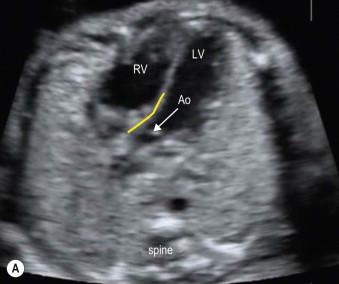
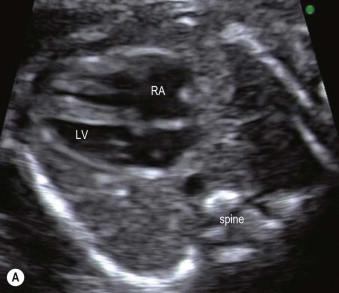
Moving sequentially towards the fetal head, the next transverse section will demonstrate the pulmonary artery ( Figure 14-16 ). The pulmonary artery arises anteriorly, close to the chest wall and is directed straight back towards the spine. This plane demonstrates the three vessel view (3VV). It images the right ventricular outflow tract and duct, with the aorta and superior vena cava cut in short axis and lying to the right of the pulmonary artery. A further sweep cranially will demonstrate the transverse arch ( Figure 14-17 ). Slight angling of the transducer on this plane will allow the duct and arch to be seen in the same section ( Figure 14-18 ). The initial direction of the aorta, at its origin from the heart, is cranial and towards the right shoulder, then it turns posteriorly and towards the left shoulder to form the aortic arch. In contrast, the pulmonary artery course is straight, just to the left of the midline and directed posteriorly towards the spine.
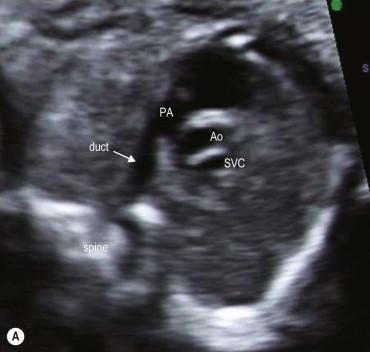
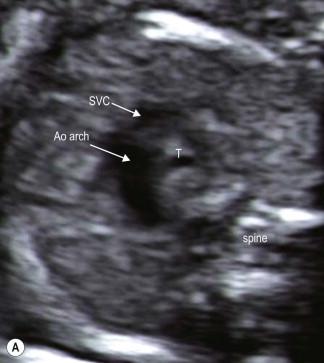
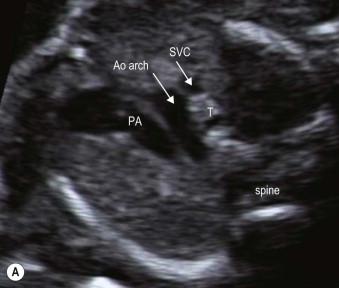
An advanced study may include examination of origin of the head and neck vessels from the aortic arch. Normally the most proximal major branch of the aortic arch is the right common carotid and right subclavian artery arising as a common vessel (the right brachiocephalic artery). Normally the right subclavian artery is seen as a tortuous vessel directed towards the right arm, in a course which passes anterior to the trachea ( Figure 14-19 ). The left common carotid and then the left subclavian arteries arise more distally from the arch in separate origins.
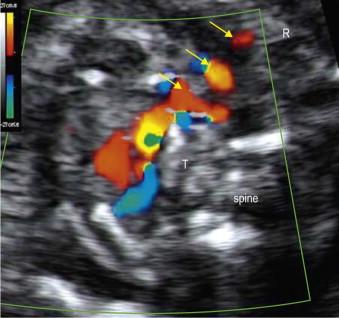
An experienced sonographer might find it useful to use long-axis or sagittal planes of the fetus, as it may be possible to demonstrate the pattern of branching of the head and neck vessels from the aortic arch, as well as crossover of the pulmonary artery ( Figure 14-20 ). In a sagittal plane, the systemic venous connections to the right atrium, the inferior and superior vena cava can be seen in longitudinal cut ( Figure 14-21 ). However, all these structures can be well seen and analyzed in the transverse views, which are easier to obtain and understand.
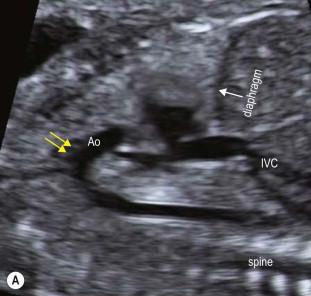
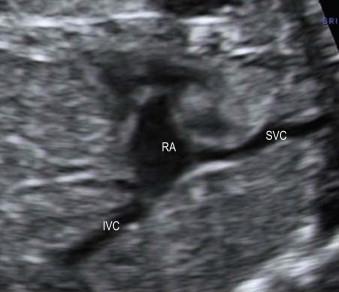
The great arteries should be examined using the same principles applied to the four-chamber view by evaluating the four features of normality: size, position, structure and function.
The two arteries are almost equal in size. The pulmonary artery is slightly bigger than the aorta from the second trimester onwards. The aortic arch (isthmus) is slightly bigger than the duct in a normal mid-trimester fetus ( Figure 14-18 ).
The aorta arises wholly from the left ventricle. It lies in the centre of the chest, unlike the pulmonary artery, which arises entirely from the anterior or right ventricle and is close to the anterior chest wall. The pulmonary trunk crosses over the aortic origin, so that the pulmonary valve lies to the left of the aortic valve ( Figure 14-18 ).
The aorta gives rise to the aortic or upper arch with characteristic head and neck vessels arising superiorly. These are the first visible branches of the aorta during fetal life, since the coronary arteries are too small to be seen. In contrast, the pulmonary artery branches early and laterally into the left and right pulmonary arteries and the arterial duct ( Figure 14-22 ). The arterial duct is a straight continuation of the main pulmonary trunk and forms the lower or ductal arch. The left aortic arch crosses the midline in front of the trachea and meets the arterial duct in front of the spine creating the so-called ‘V’ shaped appearance ( Figure 14-18 ).
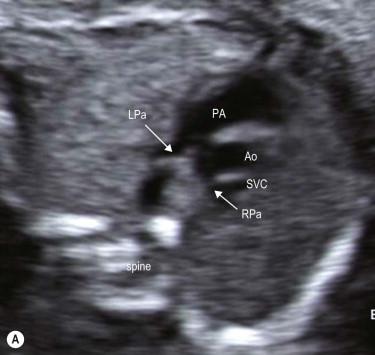
Both arterial valve leaflets appear thin and mobile. They both consist of three leaflets, an anatomical feature which is not possible to see in the fetus during the second-trimester scan.
It should be possible to see the arterial valves opening freely, disappearing in ventricular systole and appearing in diastole. Colour Doppler should demonstrate unaliased forward flow in both great arteries, as well as in the duct and arch ( Figure 14-18 ). There is no flow regurgitation seen on colour flow mapping or on pulsed Doppler of the arterial valves, as they should be competent in the normal fetal heart. The normal flow velocity in the great arteries should not exceed 80cm/sec in the second trimester.
There are several ways to classify congenital heart disease and it is widely varied in appearance and severity. It is not possible to describe every possible heart abnormality in one chapter; therefore, focus will be placed on the most common and readily distinguishable fetal heart malformations seen during routine obstetric practice. Important supplementary information is demonstrated in the accompanying tables. In addition, those who have a particular interest in the field of fetal cardiology will benefit from associated supplementary reading.
Disproportion of the ventricles
Abnormal centre (crux) of the heart:
Atrioventricular septal defect.
Absent left atrioventricular connection
Absent right atrioventricular connection
Both valves connected to one ventricle:
Double inlet ventricle
Reverse off-setting of the atrioventricular valves
Additional malformations seen in the four-chamber view:
Tricuspid valve dysplasia
Ebstein's anomaly
Ventricular septal defect
Isomerism:
Left atrial isomerism
Right atrial isomerism
Disproportion is a descriptive term with several different causes. However, it does not refer to mitral or tricuspid valve atresia where the abnormality is immediately obvious.
The disproportionate heart usually presents with both left sided chambers appearing smaller than the right. Both atrioventricular valves are patent. The appearance of disproportion may be physiological in the last 10 weeks of pregnancy ( Figure 14-12 ). On the other hand, this appearance can be associated with extracardiac causes such as:
diaphragmatic hernia;
absent ductus venosus;
intrauterine growth retardation ( Figure 14-23 );
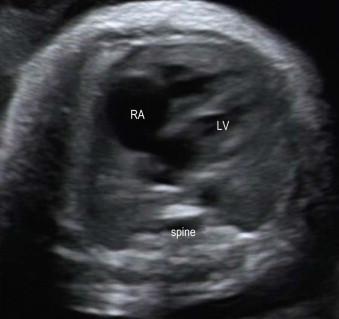
uncommon genetic syndromes;
arteriovenous malformation (vein of Galen aneurysmal malformation);
anaemia.
However, in the last two, usually there is a global cardiomegaly.
The most common cause of disproportion is coarctation of the aorta. Examination of the great arteries and aortic arch confirms this diagnosis, but suspicion is first raised during four-chamber assessment ( Figure 14-24 ). The disproportion varies, as it is dependent on the severity of coarctation. The most likely explanation for disproportion of the aorta in coarctation is that the increased afterload of the left ventricle results in a diminished right to left shunt at the foramen ovale. This reduces the left heart flow and therefore the size of the ventricle. The implications of this malformation are described under malformations of the great arteries.
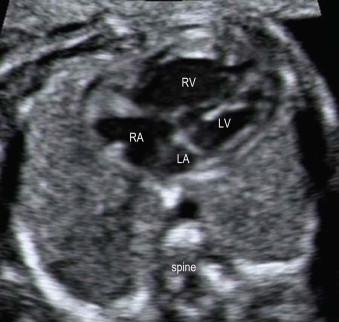
Become a Clinical Tree membership for Full access and enjoy Unlimited articles
If you are a member. Log in here